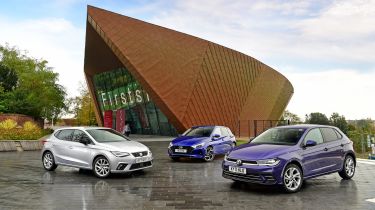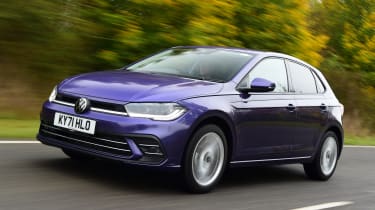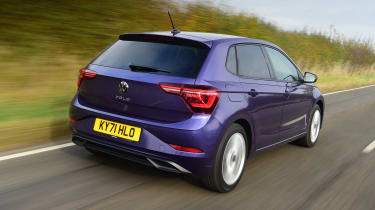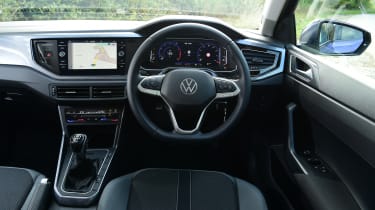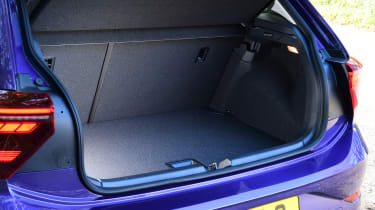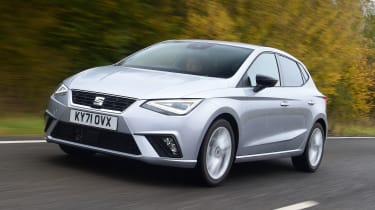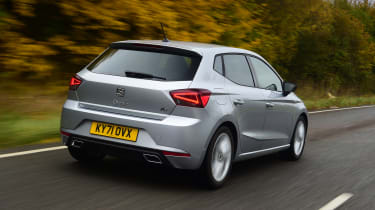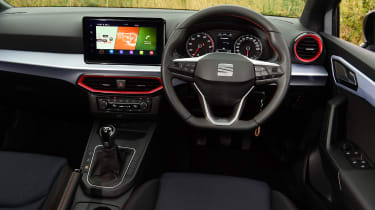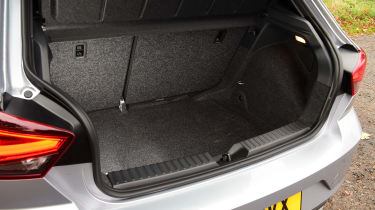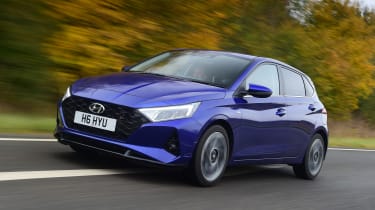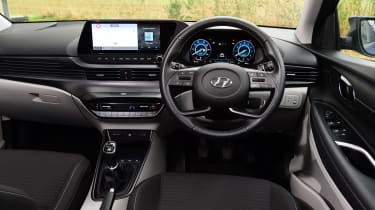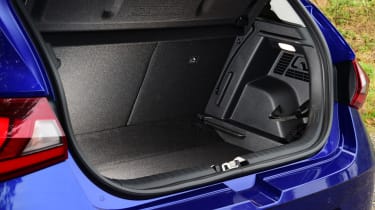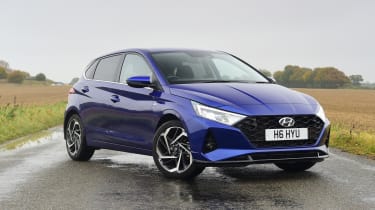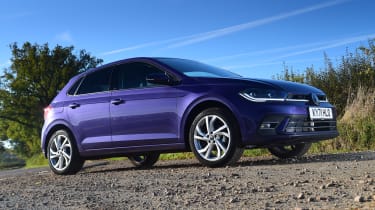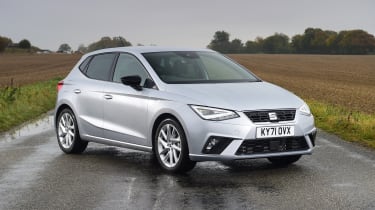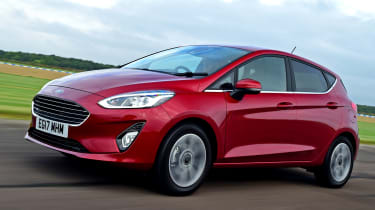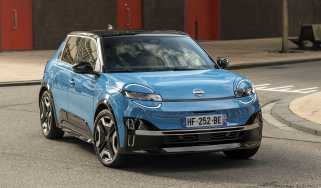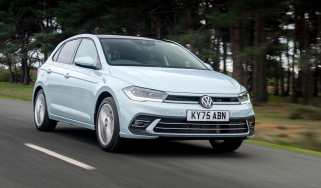Volkswagen Polo vs SEAT Ibiza vs Hyundai i20: 2021 group test review
The facelifted Volkswagen Polo goes up against the SEAT Ibiza and Hyundai i20 in this supermini showdown
Since the Polo was launched in 1975, Volkswagen has sold more than 18 million across the globe. That means one has found a home with a buyer roughly every one minute and 20 seconds for the past 46 years. So it’s not surprising that the Polo is a household name – the chances are you either know someone who has one, or you’ve owned one yourself. For decades, the Polo has been regarded as a great all-rounder that is virtually classless – a feat that few other small cars can achieve.
The competition is tougher than ever in this segment, though, so for 2021, the sixth edition of the supermini has been updated with revised styling and improved tech.
However, it’s not the only supermini that’s heading into battle here with a catalogue of improvements. The SEAT Ibiza is another ever-present contender in the segment – and the recently updated Mk5 version offers plenty for potential Polo buyers to think about.
Our second challenger is the Hyundai i20. When we first tested the Korean hatch, we found that it was a massive leap forward over its predecessor in terms of ability. It also benefits from some intriguing hybrid tech,
but can it topple VW’s icon in this class?
Volkswagen Polo
| Model: | Volkswagen Polo 1.0 TSI 95 Style |
| Price: | £20,785 |
| Engine: | 1.0-litre 3cyl turbo, 94bhp |
| 0-62mph: | 10.8 seconds |
| Test economy: | 41.0mpg/9.0mpl |
| CO2: | 119g/km |
| Annual road tax: | £155 |
One of the biggest names in this small-car class has received a makeover for 2021 – but is the nip and tuck enough to help the Polo get back to the top of the class? Here we drive a Style model finished in Vibrant Violet Metallic – a new paint colour introduced with the revised range. Including that £595 option, it costs a total of £21,380.
Used - available now
Design & engineering
First launched in 2016, the Polo Mk6 has been given a spruce-up to keep it fresh against the best in the supermini field, but also to tie its design in with newer VW models. That’s most obvious at the front, where the new grille design features a full-width light bar, similar to that seen on the Mk8 Golf. This spans slimmer headlights, while the front and rear bumpers have been reshaped. At the same time, the previously squared-off tail-lights have been replaced with units that extend further across the bootlid.
Inside, the changes are more subtle, and not necessarily positive. A new air-conditioning panel features touch-sensitive tech, where the temperature can be adjusted with either taps or swipes along slim panels. At first glance it just looks confusing; it seems like introducing change for the sake of it, rather than adding any tangible improvement in usability.
The base Life trim gets a simpler air-con system with physical controls, which simply works better. The age of Volkswagen delivering the poshest cabins time and again have passed, too; although the Polo’s cabin feels fine – and is marginally the most upmarket in this company – it no longer sets the benchmark in the supermini class.
Diesel power was phased out of the Polo line-up in 2020, and the new model continues to be petrol only. Three versions of the same 1.0-litre three-cylinder unit are available; the non-turbo unit comes with 79bhp and 93Nm of torque, while adding a turbocharger nets you either 94bhp and 175Nm, or 108bhp and 200Nm in its most powerful guise.
Driving
Out on the road, there’s very little to fault about the way the Polo drives. For a relatively small car, it’s the refinement that impresses the most; in terms of noise, comfort and its stability at speed, it could quite easily pass for a car from the class above.
It also compares favourably in this company, with the least road rumble emitted from the tyres, and thuds and knocks from the suspension are quite well isolated from the cabin. The steering is light and accurate enough, if not quite as responsive as the Hyundai’s, while the brakes are powerful, and front end dive is kept well in check during harder braking.
The VW isn’t especially fun to drive, but it corners safely and securely, which is all many buyers will want from a car such as this. As long as you don’t demand sporty handling, it’s very pleasing on the road.
The middle option in the Polo’s three-strong engine line-up is the one to have. The 94bhp model accelerates from 0-62mph in a perfectly adequate 10.8 seconds, it feels strong enough at low speed and pulls cleanly throughout the whole rev range. For such a small engine, it doesn’t ever sound strained or harsh, even under hard acceleration. The five-speed manual gearbox doesn’t like to be rushed – occasionally baulking when shifting down for an overtake, for example – but is smooth in its operation for the most part.
Practicality
Hop into the Polo’s back seats, and it delivers impressive space for a car with such modest exterior dimensions. It’s possible to fit four adults inside without much complaint, but a fifth would struggle a little.
That isn’t because of the middle seat itself, which is wide and flat, but because the central hump in the Polo’s floor is quite high and wide, which limits foot space.
Unsurprisingly, considering the number of parts they share, just four litres separates the boot volumes of the VW and the SEAT, and both rank towards the top of the class when it comes to overall carrying capacity. Unlike in the Ibiza, the Polo’s 351-litre cargo area benefits from a moveable two-level boot floor which, when the 60:40-split seat backs are folded down, allows for a level load space when placed in its raised position.
Ownership
A strong warranty is something that can give a car buyer peace of mind to mitigate against any faults in the long run. To this end, the Polo matches the Ibiza, with both brands offering the same three-year/60,000-mile cover.
Both lag behind the i20, however; not only will owners be protected for five years, but they can also drive as far as they like without invalidating the deal. This will be important to drivers who buy their cars outright, and could also influence those who take out a longer PCP or lease deal.
Running costs
Officially, the Polo returns 53.8mpg, which is only 1.6mpg short of the Hyundai i20, despite its engine missing out on mild-hybrid tech. Our real-world figure proved to be much lower; it’s worth mentioning, however, that the 41.0mpg result involved more urban driving than the figures we gathered from either rival.
That’s where these cars will spend much of their time of course, although if you do venture onto motorways more frequently, it’s not unreasonable
to expect figures nudging into the low fifties. Cover 20,000 miles at current petrol prices, and the VW would cost £3,182 if you matched that 41.0mpg figure. The SEAT achieved 41.6mpg, which comes to £3,136 over the same distance, and the 45.2mpg from the Hyundai makes it the cheapest of all, at £2,887.
Testers’ notes
“The Polo’s standard colour is Ascot Grey, a rather dreary shade more commonly used on VW’s vans. Even a bright white finish is a £360 extra.”
SEAT Ibiza
| Model: | SEAT Ibiza 1.0 TSI 95 FR |
| Price: | £19,580 |
| Engine: | 1.0-litre 3cyl turbo, 94bhp |
| 0-62mph: | 10.9 seconds |
| Test economy: | 41.6mpg/9.2mpl |
| CO2: | 125g/km |
| Annual road tax: | £155 |
While the Ibiza name doesn’t quite hold the status of the Polo in the supermini segment, it remains a big-selling car, and indeed SEAT’s most successful nameplate ever. We’re testing the latest version in FR spec here, which costs £19,580 with the 1.0 TSI 95 engine. There are no extras added to that cost either; even metallic paint is included.
Design & engineering
Flick through the Ibiza’s vital stats, and all of the numbers look remarkably similar to the Polo’s. The pair come within 15mm of one another in length, 12mm in wheelbase, and 3kg in kerbweight. The 1.0-litre three-cylinder turbocharged engine produces the same 94bhp and 175Nm, too, and the Ibiza has the same alternatives as the Polo, with one more potent and one less so.
This is, of course, because SEAT is part of the VW Group, so the pair – along with the recently launched fourth-generation Skoda Fabia – share much of their mechanical layout. They ride on the brand’s MQB-A0 platform, so they make the most of similar engine line-ups, in-car tech and safety systems.
As with the Polo, the Ibiza has been updated for 2021. SEAT’s designers have been even more subtle than their VW counterparts, though; look very closely and you’ll find new grille inserts, reprofiled bumpers and new wheel designs, plus a new font for the “Ibiza” lettering on the bootlid.
That’s perhaps because much of the redesign effort has been focused on the cabin. The dashboard is all new, with central air vents that are set lower and form part of a wide, single span across the fascia. We found the translucent red trim to look rather cheap, but it does at least add a splash of colour inside.
Driving
With so many stats that match the Polo’s, it’s no surprise to learn that the pair feel very similar to drive. The 1.0 TSI petrol unit delivers a slightly slower 10.9-second 0-62mph time, but pulls well once the turbo begins to wake up at roughly 1,500rpm. From there, the shove is consistent towards the red line. At lower speeds, the stop-start system cuts the engine from 2-3mph, enabling the driver to coast the final couple of metres before coming to a halt. Without the benefit of the Hyundai’s mild-hybrid tech, however, the engine takes longer to fire up again.
If there’s one area which separates the Ibiza from the Polo, it’s the ride – and it’s for the worse. Go for FR trim and you get firmer “sports” suspension than the rest of the range. Few will feel a benefit in handling; while it corners neatly enough and there’s slightly less body roll than in the Polo, there’s no obvious improvement in composure. Both the VW Group cars weigh the best part of 100kg more than the i20, too, so it’s going to be hard to tune in extra agility simply by adding stiffer springs.
Without that potential benefit, all you’re left with is a car that fidgets and bounces over any less-than-pristine tarmac. In isolation it wouldn’t be considered uncomfortable, but both alternatives achieve the same handling while delivering better comfort. The Ibiza’s wheels measured an inch larger than those of the Polo’s, which no doubt played a part, while the tyres (Nexen for the SEAT), produced more road roar than the Continentals fitted to the VW – and indeed the Michelins on the i20. The SEAT’s steering is light, but the lack of sensors or a camera mean it’s the hardest car of this three to park, if still not difficult.
Practicality
There's a bit of give and take with the Ibiza’s usability. On the plus side, it has the largest load volume here; there’s a total of 355 litres when the rear seats are in place, and that expands to 1,165 litres when they’re folded down. However, the area itself isn’t very versatile. In place of the false floor found in the Polo, there’s a rather flimsy carpet panel, beneath which sits a puncture repair kit.
Up front, though, storage is generous. The door bins in particular are huge, with those in the front easily able to each hold a large bottle. The glovebox is deep, too, and there’s a couple of small cupholders beside the handbrake lever. The smartphone cubby offers just enough space to neatly house a large device, but if you need to plug it in to charge via one of the two USB-C ports, it’ll sit loosely, which means it could fall out while driving. Unlike the other two here, the Ibiza does without a central cubby whose lid doubles as an armrest – there’s just a small, shallow shelf, which isn’t particularly useful
Passengers in the back benefit from large door bins, and as with the Polo, there’s more than enough knee and headroom for adults to sit comfortably.
Ownership
Based on our 2021 Driver Power brand rankings, each of these models promises a fairly similar ownership experience. When marked for overall satisfaction, SEAT, Hyundai and Volkswagen finished in 15th, 16th and 17th respectively – all just below the halfway mark.
Hyundai and VW dealers also fared similarly, with the Korean brand just pipping the German firm into 15th place. However, in comparison, SEAT’s network is highly rated among owners, scoring a very impressive fifth place overall.
Running costs
If you’re in the market for an Ibiza right now, it’s possible to make the most of a couple of offers that will keep running costs down, both initially and in the long run. SEAT’s current service offer covers the first two years of maintenance for £199, which averages out at £99.50 per year; by contrast, the first three years of Hyundai maintenance works out at £191 per year, while the VW’s costs a hefty £241 every 12 months.
Not only that, but if you head into a local dealer to test drive an Ibiza before you buy, you’ll also benefit from another £500 discount if you place an order.
Testers’ notes
“Sit in the back and it feels like the SEAT is unfinished; everything is trimmed in the same shade of dreary black plastic.”
Hyundai i20
| Model: | Hyundai i20 1.0 T-GDi 48 Volt Hybrid Premium |
| Price: | £21,000 |
| Engine: | 1.0-litre 3cyl turbo mild hybrid, 99bhp |
| 0-62mph: | 10.4 seconds |
| Test economy: | 45.2mpg/9.9mpl |
| CO2: | 118g/km |
| Annual road tax: | £145 |
Hyundai's latest models have challenged the best of the VW Group at the larger end of its range, so can the dinky i20 continue to fly the flag? This Premium trim is well equipped, but also the most expensive car here, at £21,000. Optional metallic paint adds £550 to that figure.
Design & engineering
From the outside, the i20 looks like the sportiest supermini here. The angular headlights drop down towards a grille that gives the impression of a low nose, while at the back the angular tail-lights extend into a red reflector
that stretches across the full width of the bootlid.
Step inside, however, and the i20 is less likely to win fans. Although the overall appearance is fine and the layout is logical and functional, most of the plastic looks shiny and feels very hard and unforgiving. While we weren’t expecting the premium-rivalling quality of the Tucson and Ioniq 5 to trickle down to the supermini sector, we’d hoped for better than this. At least the driving position is relaxed, and the steering wheel has a wide range of adjustment.
Like VW and SEAT, Hyundai has equipped its supermini with a small 1.0-litre turbo petrol engine. However, here there’s the added intrigue of mild-hybrid tech. A 48-volt electrical system is driven by a starter-generator unit which recovers energy when slowing down, charging a small battery under the boot floor, and deploying it under acceleration to reduce load on the engine.
The bare stats are very similar to the other two – the i20’s engine produces 5bhp more, but its peak torque is 3Nm lower, although it makes that figure at just 1,500rpm. The powertrain is paired with what Hyundai calls an intelligent Manual Transmission. In essence, iMT is an electronic clutch; without a physical link between pedal and gearbox, the hybrid tech can decouple the gearbox to save fuel.
Driving
The process of moving off has its own little quirk here; while many new cars require a pressed clutch before the engine will fire into life, the i20 insists that you press the brake pedal, too.
Once it does fire up, the small three-cylinder unit is noisier than the other two throughout the rev range, but slightly less vibration enters the cabin. It feels more muscular in the mid-range than its rivals, though, and is helped by the extra flexibility granted by the sixth gear ratio. The clutch pedal is very light, and the gearshift feels more clicky as each ratio is engaged. Whether you prefer this or the more damped feeling of the VW Group cars will come down to personal preference. Switch into Sport mode and a rev-matching system is engaged, ensuring even smoother downshifts. Sport also introduces a more excitable throttle response and
a tiny bit more steering weight – although in every mode it feels precise but with a more natural response than the VW or the SEAT’s wheel.
The i20 is also a little more fun to drive than both, and the engine feels just a little more lively. The former comes thanks to a keener feel when turning into corners and a sharper response going through them. There’s a little more roll than in the Ibiza, but movement is still well contained. It’s not to the detriment of comfort, either; the ride quality is softer than in the Ibiza, and very nearly a match for the Polo’s.
The iMT transmission allows the i20 to coast with the engine off to save fuel. It’s seamless, and the only clue it’s working is a small light glowing on the dash – although it doesn’t engage as often as we’d hope.
Practicality
Little separates these three when it comes to boot volume, with the VW, Hyundai and SEAT offering 351, 352 and 355 litres respectively. Hyundai’s mild-hybrid set-up slightly hampers the moveable boot floor, although in its lowest setting, it has to slope upwards in order to house the puncture repair kit (which has been kicked out of its usual position under the floor to make space for the mild-hybrid battery). It drops barely 30mm lower than when it’s set to its raised position, so it’s hardly worth the effort of moving it.
That minor gripe can be forgiven once you’ve settled into the back seats, though. The kneeroom on offer is excellent, headroom is a match for its rivals here and there’s less of a hump in the floor, too. Up front, the i20’s door bins aren’t quite as roomy as those in the SEAT or VW, but the glovebox is a useful size. The smartphone shelf up front is huge, and its textured surface helps to stop your device from sliding around while you’re driving. There are two USB ports and a 12-volt socket within easy reach, too.
Ownership
Safety body Euro NCAP has yet to test the i20, but it has tested the mechanically similar Bayon small SUV and awarded it four stars. Standard safety tech is generous throughout the i20 range, with forward collision warning and AEB, lane-departure warning and driver attention alert all standard.
The top-spec Ultimate trim is fitted with extras such as a lane-following system and blind-spot collision warning; until recently both of these were usually found on bigger cars. Both the Ibiza and the Polo were tested by Euro NCAP in 2017, and achieved the maximum five-star rating that year.
Running costs
Of this trio, the i20 is predicted to have the strongest residuals, holding on to just over half of its value after three years or 36,000 miles. The Polo is just marginally behind at 49 per cent, while the Ibiza brings up the rear, at 45.5 per cent. In cash terms, that means the Ibiza will be worth £8,899 in three years’ time, while the Polo and i20 will be worth £10,174 and £10,525 respectively.
Testers’ notes
“The ‘Sounds of Nature’ function plays relaxing audio, such as waves or a crackling fireplace. We’re not sure the sound of drizzle will be popular in the UK.”
Verdict
First place: Hyundai i20
It's a close result, but the i20 takes the win here. It’s the most fun to drive of this trio, yet feels no less refined. It’s similarly practical, the in-car tech looks great and is the easiest to use, and it’s a little cheaper to fuel in real-world driving. The cheap-feeling interior is something of a downside, but neither of its rivals cover themselves in glory in that regard, either. That aside, however, the i20 is a great all-rounder.
Second place: Volkswagen Polo
The latest updates haven’t transformed the Polo into a class leader, but it remains a strong contender with few obvious flaws. The Polo takes second over its SEAT sibling here on account of it being more comfortable on the road, while the options list allows buyers to pick key extras without forking out for more expensive trim levels. It drives well, but the best in this class deliver more for your cash.
Third place: SEAT Ibiza
All three of these cars are incredibly closely matched, so despite a third-place finish, the Ibiza is far from a poor effort. The fidgety ride of the sporty FR trim lets it down, but otherwise it’s near-identical to the Polo to drive,
and just as spacious. Although the base Ibiza proves to be the cheapest here on a finance deal, its kit list is a little miserly, which means it’s no better value for money.
Also consider...
- Model: Renault Clio TCe 90 S Edition
- Price: £19,100
- Engine: 1.0-litre 3cyl, 89bhp
On balance the Clio doesn’t drive quite as well as the Polo, nor is its three-cylinder turbo engine as flexible. But in all other areas the Renault has an edge; it’s more practical, better equipped and feels more expensive, even though it’s cheaper.
- Model: Ford Fiesta 1.0 EcoBoost ST-Line
- Price: £20,720
- Engine: 1.0-litre 3cyl, 99bhp
It’s a given that if you want a supermini that’s brilliant to drive, then you buy a Fiesta. But there’s much more to appreciate than just its engaging handling. The engine is smooth, there’s decent space inside, and there’s more tech in the facelifted model.
Figures
| Hyundai i20 1.0 T-Gdi Premium | Volkswagen Polo 1.0 TSI 95 Style | SEAT Ibiza 1.0 TSI 95 FR | |
| On the road price/total as tested | £21,000/£21,550 | £20,785/£21,380 | £19,580/£19,580 |
| Residual value (after 3yrs/36,000) | £10,525/50.1% | £10,174/49.0% | £8,899/45.5% |
| Depreciation | £10,475 | £10,611 | £10,681 |
| Annual tax liability std/higher rate | £1,122/£2,244 | £1,110/£2,219 | £1,083/£2,167 |
| Annual fuel cost (12k/20k miles) | £1,732/£2,887 | £1,909/£3,182 | £1,882/£3,136 |
| Insurance group/quote/VED | 13/£385/£145 | 10/£410/£155 | 11/£425/£155 |
| Cost of 1st/2nd/3rd service | £573 (3 years) | £722 (3 years) | £199 (2 years) |
| Length/wheelbase | 4,040/2,580mm | 4,074/2,552mm | 4,059/2,564mm |
| Height/width | 1,450/1,775mm | 1,451/1,751mm | 1,447/1,780mm |
| Engine | 3cyl in-line/998cc | 3cyl in-line/999cc | 3cyl in-line/999cc |
| Peak power/revs | 99/4,500 bhp/rpm | 94/5,000 bhp/rpm | 94/5,000 bhp/rpm |
| Peak torque/revs | 172/1,500 Nm/rpm | 175/2,000 Nm/rpm | 175/2,000 Nm/rpm |
| Transmission | 6-spd e-man/fwd | 5-spd man/fwd | 5-spd man/fwd |
| Fuel tank capacity/spare wheel | 40 litres/repair kit | 40 litres/repair kit | 40 litres/repair kit |
| Boot capacity (seats up/down) | 352/1,165 litres | 351/1,125 litres | 355/1,165 litres |
| Kerbweight/payload/towing weight | 1,065/530/1,110kg | 1,172/448/1,000kg | 1,169/481/1,200kg |
| Turning circle | 10.4 metres | 10.6 metres | 10.6 metres |
| Basic warranty (miles)/recovery | 5yrs (unlimited)/5yrs | 3yrs (60,000)/1yr | 3yrs (60,000)/2yrs |
| Driver Power manufacturer/dealer pos | 16th/15th | 17th/16th | 15th/5th |
| NCAP: Adult/child/ped./assist/stars | N/A | 96/85/76/59/5 (’17) | 95/77/76/60/5 (’17) |
| 0-62mph/top speed | 10.4 secs/117mph | 10.8 secs/116mph | 10.9 secs/116mph |
| Auto Express econ (mpg/mpl)/range | 45.2/9.9/398 miles | 41.0/9.0/361 miles | 41.6/9.2/366 miles |
| WLTP combined | 55.4mpg | 53.8mpg | 51.3mpg |
| WLTP combined | 12.2mpl | 11.8mpl | 11.3mpl |
| Actual/claimed CO2/tax bracket | 144/118g/km/27% | 159/119g/km/27% | 157/125g/km/28% |
| Airbags/Isofix/parking sensors/camera | Six/yes/rear/yes | Seven/yes/F&R/yes | Six/yes/no/no |
| Auto box/lane keep/blindspot/AEB | £1,250/yes/no/yes | No/yes/no/yes | No/yes/no/yes |
| Climate control/cruise control | Yes/yes | Yes/yes | Yes/yes |
| Leather/heated seats | No/yes | No/no | No/no |
| Metallic paint/LED lights | £550/yes | £595/yes | £0/yes |
| Keyless entry & go/power tailgate | No/no | No/no | No/no |
| Sat-nav/digital dashboard | Yes/yes | Yes/yes | Yes/no |
| DAB/connected services | Yes/yes | Yes/yes | Yes/yes |
| Wireless charge/CarPlay/Android Auto | No/yes/yes | No/yes/yes | No/yes/yes |
